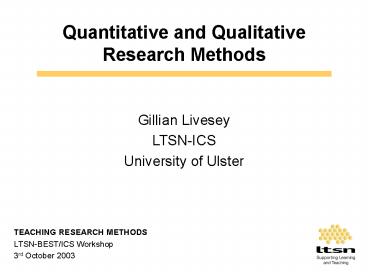Quantitative and Qualitative Research Methods - PowerPoint PPT Presentation
1 / 20
Title:
Quantitative and Qualitative Research Methods
Description:
Point-biserial Correlation. Continuous. t-test. ANOVA. Regression. Point-biserial Correlation. Chi-square. Logistic Regression. Phi. Cramer's V. Dichotomous ... – PowerPoint PPT presentation
Number of Views:6001
Avg rating:5.0/5.0
Title: Quantitative and Qualitative Research Methods
1
Quantitative and Qualitative Research Methods
Gillian Livesey LTSN-ICS University of Ulster
- TEACHING RESEARCH METHODS
- LTSN-BEST/ICS Workshop
- 3rd October 2003
2
Overview
- Qualitative and Quantitative Research
- Purpose of Research
- Qualitative and Quantitative Methods
- Teaching
- Resources
- Assessment
3
Research Methods
- Research methods are generally categorised as
being either quantitative or qualitative. - What matters is that the methods used fit the
intended purposes of the research!
4
Qualitative and Quantitative Paradigms
- The qualitative paradigm concentrates on
investigating subjective data, in particular, the
perceptions of the people involved. The intention
is to illuminate these perceptions and, thus,
gain greater insight and knowledge. - The quantitative paradigm concentrates on what
can be measured. It involves collecting and
analysing objective (often numerical) data that
can be organised into statistics.
5
Qualitative and Quantitative Research
6
Research
- The purposes of research can be categorised as
- Description (fact finding)
- Exploration (looking for patterns)
- Analysis (explaining why or how)
- Prediction (forecasting the likelihood of
particular events) - Problem Solving (improvement of current practice)
7
Descriptive Research
- Seeks to accurately describe current or past
phenomena - to answer such questions as
- What is the absentee rate for particular
lectures? - What is the pass rate for particular courses?
- What is the dropout rate on particular degree
programmes? - What effect does a particularly quality audit
process have on teacher morale?
8
Analytical Research
- Seeking to explain the reasons behind a
particular occurrence by discovering causal
relationships. Once causal relationships have
been discovered, the search then shifts to
factors that can be changed (variables) in order
to influence the chain of causality. Typical
questions are
- Why is there a preponderance of female students
on 1st level teacher training programmes? - What factors might account for the high drop-our
rate on a particular degree programme?
9
Predictive Research
- Seeks to forecast the likelihood of particular
phenomena occurring in given circumstances. It
seeks to answer such questions as
- Will changing the start time achieve a higher
attendance rate at our lectures? - Will introducing anonymous marking reduce the
gender imbalance in the achievement of 1st class
degrees? - Will increasing the weighting for course work
encourage students to adopt deep learning
strategies?
10
Problem Solving Research / Action Research
- Action-research is a form of problem solving
based on increasing knowledge through observation
and reflection, then following this with a
deliberate intervention intended to improve
practice.
- Educational action-research describes a family of
activities in curriculum development,
professional development, school improvement
programmes, and systems planning and policy
development. - Participants in the action being considered are
intricately involved with all of these activities.
11
Typical Methods
12
Research Methods Categorised by Activity
13
Teaching Elementary Concepts
- What is a Variable?
- Scales of Measurement
- Qualitative -v- Quantitative
- Continuous -v- Categorical / Dichotomous
- Independence -v- Dependence
14
Teaching Selecting Statistics
15
- William Gossett - nicknamed Student was a
chemist at the Guinness brewery in Dublin and
developed the student t-test in 1908 to ensure
that each batch of Guinness was as similar as
possible to every other batch! The t-test is used
to compare two groups and comes in at least 3
flavours.
16
Teaching Software
- Spreadsheets
- EXCEL
- Statistical Software
- SPSS (http//www.spss.com/)
- MINITAB (http//www.minitab.com/)
- SAS (http//www.sas.com/)
17
Resources
http//trochim.human.cornell.edu/
18
Resources
http//www.socsciresearch.com/
19
Assessment
- Written a report, research proposal or
evaluation - Group Work interdisciplinary groups
- VLE internet
- Peer Tuition
- Peer Assessment
- Multiple Choice maybe online
- Exam written or using computer
- CAA, QTI
20
Conclusion
- What matters is that the methods used fit the
intended purposes of the research!































